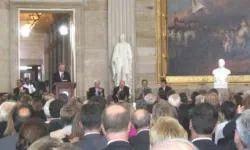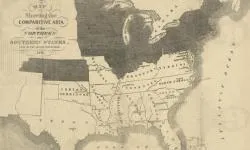Principal Investigator: Peter Kastor, Washington University in St. Louis
Creating a Federal Government explores the functional realities of governance during the early American republic. In an age of limited fiscal resources, powerful opposition to expansive government powers, and a constitutional structure that restricted many powers to the states, how would the United States go about appointing citizens to public office and managing their activities? Creating a Federal Government explores the meanings of power in a revolutionary age, but not in the way that many Americans now associate with the American Revolution. This project considers how Americans attempted to distribute appointed power from above in an age when Americans were struggling to create a government where power flowed from below.
To support these questions about the implementation of federal power in the early republic, CFG is compiling exhaustive data on the making of federal appointments. Using the Senate Executive Journal (transcribed by Library of Congress's American Memory project) and the [territorial papers] as sources, the project is building a database of appointments; and using various other sources, is building a database of applications for federal appointments. Because it's clear that this data could support more questions than CFG is presently asking, part of the goal of the project is a kind of data reuse effort: thus, in addition to a book by the project Director, another main product will be a publicly accessible scholarly resource which will present the aforementioned data as well as GIS-enabled visualizations and richly encoded supporting texts.

Database of Senate Confirmations, 1789 - 1730
Over a period of several summers, and with the essential help of a number of undergraduate and graduate students, we've build a database containing information on over 5,000 federal appointments which required confirmation by the Senate. The data covers the period of 1789 to 1830, and include appointments for the cabinet, the judiciary, customs officers, and more.
To support the entry, review and correction of the data, the HDW deployed its standard, open-source relational database management solution. Data is stored in a MySQL database. Users access the database through an HDW-customized version of the Django admin functions., and additional Django customizations were written specifically for the project. The database application is served from an OS/X server, and a sandbox was created on a separate Linux server so students could explore the data using command line, spreadsheet and Google tools.
 Historical GIS
Historical GIS

During the summer '09 workshops, the students working on this project discovered that there was no complete set of GIS shape files describing the changes in the United States' national, territorial and state boundaries between 1789 and 1830. We saw this as a disappointment, since a number of the questions about federal appointments are about the location of such appointments. For example, we might ask if more appointments went to the settled east, or to the expanding frontier territories. Or we might ask if the appointment of customs officers matched the expansion of the republic west along the Gulf of Mexico. While such questions can be answered without mapping, we thought the answers would be more compelling set against historically accurate boundaries.
Fortunately, we did find a good start on the data at The National Historical Geographic Information System (NHGIS). The students downloaded the NHGIS data, and supplemented them with new shape files. The result was a complete set of boundaries which met our requirements.
To support these questions about the implementation of federal power in the early republic, CFG is compiling exhaustive data on the making of federal appointments. Using the Senate Executive Journal (transcribed by Library of Congress's American Memory project) and the [territorial papers] as sources, the project is building a database of appointments; and using various other sources, is building a database of applications for federal appointments. Because it's clear that this data could support more questions than CFG is presently asking, part of the goal of the project is a kind of data reuse effort: thus, in addition to a book by the project Director, another main product will be a publicly accessible scholarly resource which will present the aforementioned data as well as GIS-enabled visualizations and richly encoded supporting texts.

